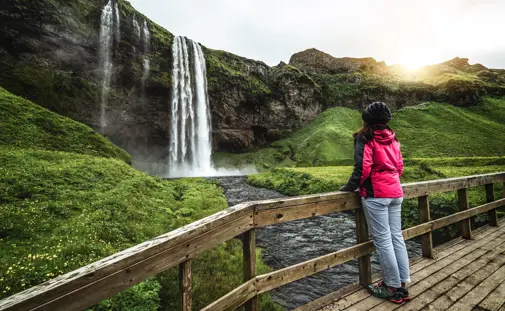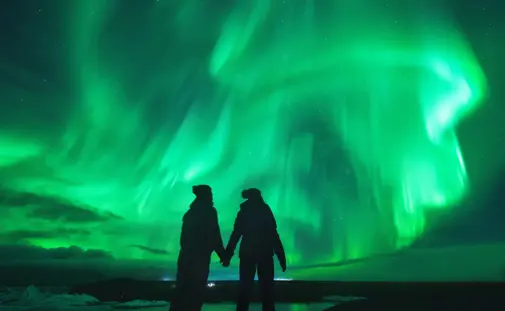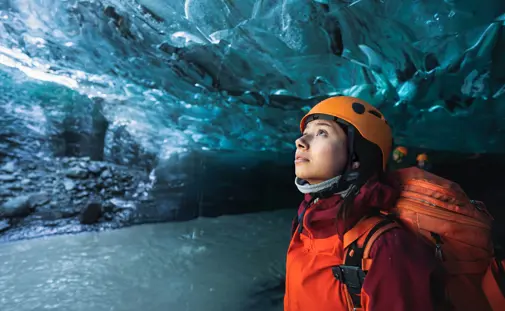Diamond Beach is a captivating natural wonder located in Iceland, near the Jökulsárlón Glacier Lagoon. This unique stretch of coastline gets its name from the striking icebergs that dot the black volcanic sand, resembling scattered diamonds. These icebergs, which break off from the Breiðamerkurjökull Glacier, drift into the lagoon before being carried out to sea and eventually washed ashore. The contrast between the glistening ice and the dark sand creates a surreal, almost otherworldly landscape that is a photographer's dream.
The beach is a popular spot for visitors who are drawn to its ethereal beauty and the ever-changing display of ice sculptures, which can range from small, crystal-clear fragments to massive, jagged blocks of deep blue ice. The best time to visit is during the winter months when the icebergs are more abundant, and the chances of seeing the Northern Lights add an extra layer of magic to the experience.
In addition to its visual appeal, Diamond Beach is also a place of contemplation, where the power of nature is on full display. The sight of the ice slowly melting and returning to the ocean is a reminder of the Earth's natural cycles and the transient beauty of our planet.
Diamond Beach Facts
- Location: Southeast Iceland, near Jökulsárlón Glacier Lagoon
- Coordinates: 64.0446° N, 16.1784° W
- Distance from Reykjavik: Approximately 370 kilometers (230 miles)
- Beach Length: Roughly 18 kilometers (11 miles)
- Black Sand Formation: Formed from volcanic activity and glacier sediments
- Icebergs Origin: From Breiðamerkurjökull, an outlet of Vatnajökull Glacier
- Best Time to Visit: Year-round, but winter provides opportunities to see the Northern Lights
- Time on Site: Plan to spend at least 1 to 2 hours exploring the beach and nearby lagoon.
What is Diamond Beach?
Diamond Beach Iceland is a remarkable natural phenomenon that involves large chunks of ice from Jökulsárlón Glacier Lagoon landing on the black volcanic sands of Breiðamerkursandur. The name refers to the fact that the icebergs get worn smooth and shiny by the ocean, hence sparkling like diamonds in the sunlight. It is situated at that very point where Jökulsárlón meets the North Atlantic; this beach, therefore, is a natural gathering place for these icebergs when they break off from the glacier.
Diamond Beach's formation is due to pure natural processes, and its beauty is shaped by the forces of nature. The black sand of this beach comes from the effects of volcanic activity and glacial outwash plains, most notably of Breiðamerkurjökull, Hrútárjökull, and Fjallsjökull origin. These are part of the Vatnajökull ice cap, which is Europe's largest glacier. Over centuries, these glaciers have ground the underlying rocks into fine sediment and form gigantic black sand plains stretching along the coastline.
These icebergs originate from the Jökulsárlón Glacier Lagoon. These huge lumps of ice break off from Breiðamerkurjökull and float across the lagoon until they drift down the short river leading it to the ocean. On its movement toward the ocean, the salty waves polish the icebergs before the tide pushes them back onto the black sand-thus the dazzling view of the scattered ice diamonds on the beach.
Black Sands
That black sand in Diamond Beach is a product of Iceland's volcanic activity. Whenever there is a volcanic eruption either under a glacier or in some other type of water-rich environments, the lava cools down pretty quickly, shattering into tiny fragments of basalt carried along by the glaciers and rivers until they are finally discharged at the coast. Over time, the waves of the Atlantic Ocean grind this volcanic rock into the fine, jet-black sand that defines Diamond Beach.
Icebergs from Jökulsárlón
The icebergs that wash up on Diamond Beach in Iceland come from Jökulsárlón Glacier Lagoon, just across the road from the beach. Large pieces of the Breiðamerkurjökull Glacier break off into the lagoon, where they float and very slowly make their way out to sea. These icebergs can be small, sparkling fragments or enormous structures, taller than a person, and hundreds of years old. Because of this constant motion, no visit to Diamond Beach is the same since the scenery is in everlasting flux.
Where to Stay Near Diamond Beach?
There are several places to stay near Diamond Beach Iceland, ranging from comfortable hotels to cozy guesthouses and campsites. Fosshótel Glacier Lagoon is a popular option, offering modern amenities and breathtaking views of Vatnajökull and the surrounding landscape. Gerði and Hali Country Hotel, located near Jökulsárlón, offers a more intimate and rural experience, perfect for travelers seeking tranquility.
For budget-conscious travelers, Guesthouse Skálafell is a welcoming and affordable option located within driving distance of Diamond Beach. Additionally, the area has several camping sites available for those looking to experience Iceland’s natural beauty up close, both in Skaftafell and Höfn. Each location is about an hour away from the lagoon, Skaftafell to the west and Höfn to the east.
Where is Diamond Beach?
Diamond Beach is located in southeast Iceland, right off the Ring Road (Route 1), near Jökulsárlón Glacier Lagoon. It is approximately 370 kilometers (230 miles) east of Reykjavik, making it accessible as part of a day trip or multi-day journey along Iceland’s famous South Coast.
-
GPS Coordinates: 64°02'40.7"N 16°10'39.1"W
How to Get to Diamond Beach?
Diamond Beach Iceland is accessible by the Road Ring, otherwise known as Route 1, running southeast from Reykjavik. The drive covers about 370 kilometers, taking approximately 5 to 6 hours. You will be given the opportunity to pass other beautiful places while en route, including Vík, Skógafoss, and Skaftafell National Park.
In case you drive from Vik, Diamond Beach is about 192 kilometers, taking approximately 2.5 hours of driving. Diamond Beach lies exactly opposite the road from Jökulsárlón Glacier Lagoon, so visiting these two places could definitely fit in one trip.
Parking & Facilities
Diamond Beach is easy to park at; there are clear areas for cars and tour buses. There is a car park pretty much right off the beach from which the visitor can simply walk down to the shore. Across the road, at Jökulsárlón Glacier Lagoon, there are restrooms available, as well as a small café where one can purchase snacks and hot beverages. Just be careful if you choose to cross the road on foot, as there are no dedicated cross walks on Route 1.
Can You See the Northern Lights from Diamond Beach?
You can witness the Northern Lights from Iceland’s Diamond Beach. In the period between September and April, the grounds are dark enough and adequately far from major cities to offer great viewing of the Aurora Borealis. The sight of the Northern Lights dancing above the glittering icebergs on the black sand beach is truly magical. The beach’s remote location and open skies make it one of the best spots in Iceland for aurora hunters.
Diamond Beach in Winter and Summer
Diamond Beach is an attraction all year round, but with each season, the magic of this place unravels in varied ways. During winter, the chunks of icebergs become more imposing, and if you’re lucky enough to see the Northern Lights they’ll add beauty to the already beautiful landscape. The cold gives the beach a surreal, icy landscape completely out of this world. In summer, the midnight sun shines brightly upon the beach and makes the icebergs sparkle against the black sand. It's magical in any season.




